Blog Archives
Satan Town (Pathé, 1926)
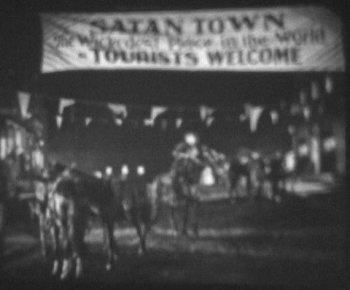 Satan Town (Pathé, 1926)
Satan Town (Pathé, 1926)
Directed by Edmund Mortimer
Starring Harry Carey and Kathleen Collins
Ladies and gentlemen, I feel that I need to apologize. I don’t often watch videos. Usually when I watch something, I’m screening a film print. When I’m running something that I’ve half a mind to write about, I’ll have a video camera off to the side vaguely pointed at the screen so that I’ve got a file to pull screenshots from. It’s sometimes out of focus and poorly exposed, and maybe the top or bottom of the frame is cropped off, and the picture is always horribly skewed, but everything went wrong with today’s screenshots. I am sorry.
Satan Town — “The Wickedest Place in the World – Tourists Welcome”, so says the banner across main street. Bill Scott (Harry Carey) rides into the city looking for adventure. At the Palace Hotel, the wickedest place in Satan Town, Sue (Kathleen Collins) of the Salvation Army strives to reach one or two of the drunks, gamblers, and prostitutes that throng the saloon.
Malamute (Ben Hendricks), the bouncer at the bar, never shies from a fight, and what’s more, he’s never lost one. Sue, to her misfortune, has gotten on his nerves. Bill enters just in time to get between Malamute and Sue. After a brief but spirited battle, Malamute is bested.
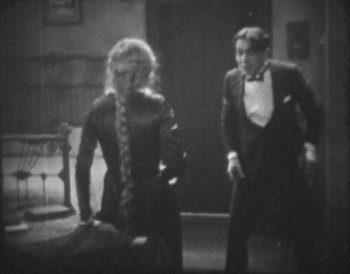 It doesn’t end there, of course. Malamute attempts revenge several times and is repelled by Bill at each turn. The direct approach not working, Malamute tries a more indirect route. Sue gets a letter from Pearl, a prostitute at the Palace, saying that she’s ill. When Sue gets to room 16, however, she’s met only by Frisco Bob (Charles Delaney), the band leader. Bob is in cahoots with Malamute to ruin Sue’s reputation and thus drive her out of town. As Bob approaches menacingly, Sue picks up a convenient gun that was left on the table. Bob is undeterred. When he’s almost on her, she fires. Bob is not hit. The girl standing in the doorway, however, is. Pearl crumples to the floor, dead.
It doesn’t end there, of course. Malamute attempts revenge several times and is repelled by Bill at each turn. The direct approach not working, Malamute tries a more indirect route. Sue gets a letter from Pearl, a prostitute at the Palace, saying that she’s ill. When Sue gets to room 16, however, she’s met only by Frisco Bob (Charles Delaney), the band leader. Bob is in cahoots with Malamute to ruin Sue’s reputation and thus drive her out of town. As Bob approaches menacingly, Sue picks up a convenient gun that was left on the table. Bob is undeterred. When he’s almost on her, she fires. Bob is not hit. The girl standing in the doorway, however, is. Pearl crumples to the floor, dead.
The evidence is against her and Sue is arrested. On the way to jail, Bob rides in and sweeps up Sue. A mob forms to retake her, but just then, a woman appears (I don’t know who it is — doesn’t really matter) and tells them that Pearl isn’t really dead. All of it was staged to frame Sue — Pearl and Bob are laughing it up at the bar this minute. Malamute, who’s been in the background all along, sees his plans unraveling before his eyes. He pulls his gun to shoot Sue, but Bill’s quicker and shoots him first.
The worm begins to turn. The mob rather suddenly switches sides. “Let’s wipe out the whole rotten town!” a woman cries. The way it’s acted and blocked, the scene plays out very much like the False Maria inciting the workers scene in Metropolis, so much so that, if it weren’t for the fact that this film is a year older, I’d say it was ripped off from it. As it is… well, I wonder if Fritz Lang was a fan of westerns.
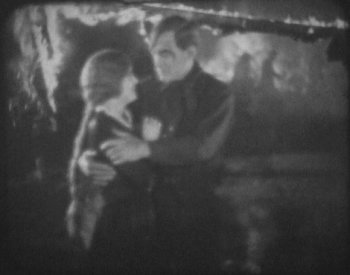 Bill and Sue embrace in the middle of the road, the town literally in flames around them as a crazed torch-wielding mob races about in a frenzy of destruction, left “to a life of peace and happiness”.
Bill and Sue embrace in the middle of the road, the town literally in flames around them as a crazed torch-wielding mob races about in a frenzy of destruction, left “to a life of peace and happiness”.
I liked it. The film’s kinda hokey, its plot’s a little thin and what plot it has is well-worn, Carey is very much taking his cues from William S. Hart’s good bad man shtick and the whole story bears more than a passing resemblance to Hell’s Hinges (1916), but for all that, I liked it. It helps that it’s easy to look at, being very well acted and expertly shot (though the screenshots may not seem so). And the title is great; how could anything called Satan Town be bad?
The only questionable things are a couple of weird tonal shifts. The film was advertised as a western drama and nothing else. For everything between the first scene and the last, I wouldn’t argue that. It is, on the whole, a melodrama that’s played completely straight, but the satire is so in your face at the open and close that I can’t believe it was unintentional. I’m not sure what they were going for with that.
My rating: I like it.
The next video out will be an HD remaster of The Victoria Cross (1912). After that, I’m not so sure, but I’m leaning toward The Doll-House Mystery (1915) or maybe The Dancer (1916).
J’accuse (Pathé, 1919)
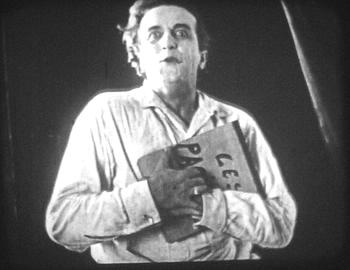 J’accuse (Pathé, 1919)
J’accuse (Pathé, 1919)
Directed by Abel Gance
Starring Romuald Joubé
This isn’t a review, but I know I haven’t posted much recently (for various reasons neither here nor there) so I thought I’d just comment on something exciting to me.
Around nine years ago, I bought four bobbins of the 9.5mm Pathé Baby version of J’accuse (1919). Since then, I’ve been picking up more when and where ever I could find them. At last, I’ve assembled the entire film. Actually, with the duplicates resulting from buying so many incomplete sets, I’ve got nearly two copies.
At 840 feet, it’s considerably abridged from the theatrical release (which wasn’t even available on video when I started the collection). If it was run straight, 840 feet works out to around 28 minutes, but J’accuse has notched titles so it’s actually a bit longer than that. The original Pathé Baby projector could only handle a 30 foot film bobbin, which is just a minute of footage. Even if a film only 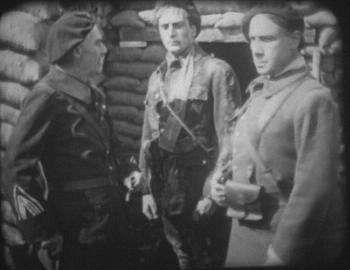 has two or three intertitles, text would quickly eat up almost all the runtime. To save film, the Baby had a unique system whereby a little arm feels along the edge of the film as it passes through the projector. When it encounters a notch, it stops advancing the film for a few seconds — holding the picture on the screen. This way, titles could be reduced from several feet down to just a couple frames. Later Babies doubled the max capacity to 60 feet, and at last Pathé ditched bobbins for conventional reels that could handle several hundred feet of film, but J’accuse is an early release. 30 feet with notched titles generally becomes 50 feet with running titles, so it’s probably closer to 45 minutes long.
has two or three intertitles, text would quickly eat up almost all the runtime. To save film, the Baby had a unique system whereby a little arm feels along the edge of the film as it passes through the projector. When it encounters a notch, it stops advancing the film for a few seconds — holding the picture on the screen. This way, titles could be reduced from several feet down to just a couple frames. Later Babies doubled the max capacity to 60 feet, and at last Pathé ditched bobbins for conventional reels that could handle several hundred feet of film, but J’accuse is an early release. 30 feet with notched titles generally becomes 50 feet with running titles, so it’s probably closer to 45 minutes long.
The whole notch system was a trade-off. With notched titles, the projector by necessity could only use weak lamps that threw small, dim pictures. More powerful lamps burned too hot and would melt the film if it was held in the gate for longer than a fraction of a second. The Baby’s lamphouse is really not much more than a flashlight.
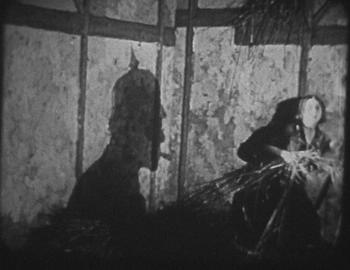 There is an edit of the film that cuts out the whole ghost sequence at the end (before the 2008 DVD was released, I believe it was the most commonly available version on video), but the Baby edition retains it. I haven’t done a side-by-side comparison, but it seems like most of the Baby’s severest abridging is towards the start of the film.
There is an edit of the film that cuts out the whole ghost sequence at the end (before the 2008 DVD was released, I believe it was the most commonly available version on video), but the Baby edition retains it. I haven’t done a side-by-side comparison, but it seems like most of the Baby’s severest abridging is towards the start of the film.
Abel Gance and George Lucas have a bit in common — both being rather notorious for continually revising their films. It’s difficult to say what the “definitive” version of J’accuse would even look like. It’s certainly not the Baby release, but even the DVD is still missing as much as six reels’ worth of footage if by “original” you mean Gance’s earliest cuts of the film. The Baby version at least retains the three-epoch structure of the theatrical release, which the pre-2008 video didn’t.
Of all the Gance films I’ve seen, J’accuse remains my favorite. It may be heresy for me to say so, but Napoleon requires rather more patience than I’m willing to give. It has some spectacular and expertly constructed sequences, Napoleon does, but the road between them is a slog.
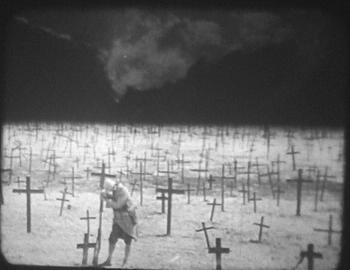 As for the delay in releasing a new video: the film scanner broke after transferring An Old Man’s Love Story. It was an easy fix, but I had to wait for a replacement part to arrive from Singapore, which took over a month. The primary scanner broke, I should say — I have four. The print I’m scanning now is a bit too shrunken to run through a standard movement, and the machine I’m talking about is one I built myself specifically to handle shrunken and badly damaged film. Here’s a hint for what’s coming out next. It’s an HD remaster of a very old title in the catalogue involving a washerwoman who gets stiffed by one of her customers.
As for the delay in releasing a new video: the film scanner broke after transferring An Old Man’s Love Story. It was an easy fix, but I had to wait for a replacement part to arrive from Singapore, which took over a month. The primary scanner broke, I should say — I have four. The print I’m scanning now is a bit too shrunken to run through a standard movement, and the machine I’m talking about is one I built myself specifically to handle shrunken and badly damaged film. Here’s a hint for what’s coming out next. It’s an HD remaster of a very old title in the catalogue involving a washerwoman who gets stiffed by one of her customers.
Other news that may or may not be of interest: we’re trial-running putting the “now playing” video on YouTube as well on the homepage of our website. If it goes well, we’ll keep doing it. If it goes really well (viz., if the ad revenue matches the sale price), then maybe the now playing videos will cease to be a limited, one-at-a-time thing and the entire now playing catalogue will be made available.
La Maison Ensorcelée (Pathé, 1908)
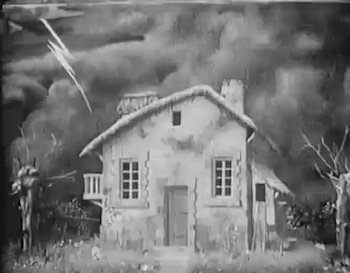 La Maison Ensorcelée (Pathé, 1908)
La Maison Ensorcelée (Pathé, 1908)
Directed by Segundo de Chomón
To begin with, Segundo de Chomón’s La Maison Ensorcelée (1908), or “The Enchanted House”, is a beat-for-beat rip-off of J. Stuart Blackton’s The Haunted Hotel (1907). There’s long been confusion about who was stealing from whom, as the film is often misidentified as La Maison Hantée (“The Haunted House”), which Chomón made two years before in 1906. Hantée is presumed to be lost — however, reading its plot synopsis or just looking at the recorded run time will tell you that Hantée had to be an entirely unrelated work.
Three people, evidently traveling across the countryside, are caught in the rain. They spot a house that, frankly, doesn’t look too inviting. Between bolts of lightning, a trio of witches can be seen flying through the sky. One bolt strikes the house and it’s transformed into a googly-eyed face.
Inside, the travelers are immediately taunted by spectral beings of various sorts — finding their belongings moving around on their own, and their coats and hats standing up and walking away. They sit down to a meal. A knife lifts itself and slices the sausage and bread. The cups slide into place and an invisible hand pours out the coffee and drops sugar cubes into each.
It turns ugly when the house starts spinning and the travelers are flung to the ground. They seek shelter under the covers of the bed, but the back wall fades away and a giant demon appears that sweeps them up in one hand. In the forest, he leaves them dangling from a high tree branch.
The only significant change in the story between La Maison Ensorcelée and The Haunted Hotel is that, in the latter, there is only one traveler rather than three. The plot and visuals used are otherwise near identical. With that said, Ensorcelée is an enormous technical achievement that surpasses Haunted Hotel in almost every aspect.
To give only one example: In Haunted Hotel, the stop-motion animated food sequence (which the film is most known for) is one, uninterrupted medium-shot of the table. When it’s over, it pans to the traveler, who we can only assume was watching. Ensorcelée cuts to a reaction shot partway through the sequence, and at the end, the travelers lean into the frame in the same arrangement they were in previously, letting us know that they were there the whole time and saw all that we saw. It’s really not much at all, but it’s a little touch that makes the film play so much better.
I liked La Maison Ensorcelée (1908). It’s a flagrant rip-off of Blackton’s film, but it’s hardly the only example of one filmmaker mimicking another’s success in the early silent era, and unlike, say, Lubin’s Great Train Robbery (1904), I think this one actually improves on his model.
My rating: I like it.